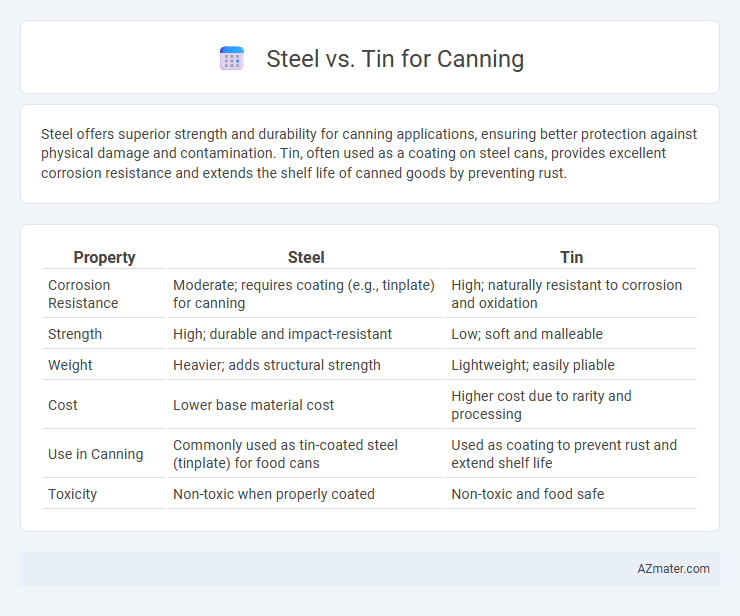Steel offers superior strength and durability for canning applications, ensuring better protection against physical damage and contamination. Tin, often used as a coating on steel cans, provides excellent corrosion resistance and extends the shelf life of canned goods by preventing rust.
Table of Comparison
| Property | Steel | Tin |
|---|---|---|
| Corrosion Resistance | Moderate; requires coating (e.g., tinplate) for canning | High; naturally resistant to corrosion and oxidation |
| Strength | High; durable and impact-resistant | Low; soft and malleable |
| Weight | Heavier; adds structural strength | Lightweight; easily pliable |
| Cost | Lower base material cost | Higher cost due to rarity and processing |
| Use in Canning | Commonly used as tin-coated steel (tinplate) for food cans | Used as coating to prevent rust and extend shelf life |
| Toxicity | Non-toxic when properly coated | Non-toxic and food safe |
Introduction to Canning Materials
Steel and tin are primary materials used in canning, each offering distinct advantages for food preservation. Steel provides exceptional strength and durability, making it ideal for structural integrity in canned goods, while tin offers corrosion resistance to protect the can's interior from acidic foods. The combination of tin-coated steel, known as tinplate, balances mechanical strength with chemical stability, ensuring extended shelf life and safety in food packaging.
Overview of Steel and Tin Used in Canning
Steel, primarily carbon steel or tinplate steel, is widely used in canning for its strength, durability, and cost-effectiveness, providing excellent protection against physical damage and contamination. Tin, used as a thin coating on steel (tinplate), enhances corrosion resistance and prevents direct metal-food contact, ensuring food safety and extending shelf life. The combination of steel's structural properties with tin's protective layer creates a robust, reliable packaging solution favored in the food preservation industry.
Durability: Steel vs Tin Cans
Steel cans offer superior durability due to their thicker gauge and resistance to punctures and dents compared to tin cans, which are typically coated steel with thinner walls. The enhanced strength of steel containers ensures better protection of contents during transportation and storage, reducing the risk of contamination or spoilage. Tin, often used for its corrosion-resistant properties, provides less mechanical strength, making steel the preferred choice for heavy-duty or long-term canned goods.
Resistance to Corrosion and Rust
Steel offers superior resistance to corrosion and rust due to its alloy composition and protective coatings, making it ideal for durable canning applications. Tin provides a natural barrier against oxidation but is softer and more prone to wear, often necessitating additional coatings to prevent corrosion over time. In food preservation, tin-coated steel cans combine the strengths of both metals, enhancing corrosion resistance and ensuring product safety.
Food Safety and Chemical Reactions
Steel cans, often coated with a thin layer of tin, provide superior food safety by preventing corrosion and minimizing chemical reactions between the metal and food. Tin's inert properties reduce the risk of metal ions leaching into acidic or salty foods, preserving taste and nutritional quality. Advances in can lining technology further enhance safety by creating barriers that prevent direct contact between food and metal, reducing contamination and prolonging shelf life.
Cost Comparison: Steel vs Tin
Steel is generally more cost-effective than tin for canning due to its lower raw material and production expenses. Tin, often used as a coating material for steel cans, increases overall costs because of its higher market price and more complex processing requirements. Choosing steel-only cans reduces manufacturing costs while maintaining durability and safety for food storage.
Sustainability and Environmental Impact
Steel cans offer superior recyclability due to their high recovery rate, with up to 60% of steel packaging being recycled globally, reducing landfill waste and conserving natural resources. Tin-plated steel extends the life of steel cans by preventing corrosion but contains small amounts of tin, which has a lower recycling rate and mining processes associated with environmental concerns like habitat disruption. Overall, steel's magnetic properties make it easier to sort and recycle in automated facilities, enhancing the sustainability profile compared to pure tin or other metal alternatives in canning.
Weight and Storage Considerations
Steel cans offer greater durability and heavier weight compared to tin, providing robust protection for long-term storage but adding significant shipping costs. Tin cans are lighter and resist corrosion better, making them ideal for reducing overall package weight and optimizing storage space. Choosing between steel and tin for canning depends on balancing weight constraints with the desired shelf life and protection level.
Common Uses in Home and Commercial Canning
Steel is commonly used in commercial canning due to its strength, durability, and ability to withstand high processing temperatures, making it ideal for large-scale food preservation such as canned vegetables, meats, and soups. Tin, often used as a coating on steel cans, provides corrosion resistance and prevents food contamination, which is crucial for maintaining food safety in both home and commercial canning environments. Home canners typically use tin-coated steel cans to store fruits, jams, and pickled products, leveraging the materials' combined protective qualities to ensure long shelf life and freshness.
Final Recommendation: Choosing the Right Material
Steel offers superior strength, durability, and resistance to impact, making it ideal for heavy-duty canning applications. Tin provides excellent corrosion resistance and is often used as a coating on steel cans to enhance food safety and shelf life. For optimal performance, choose steel cans coated with tin to balance structural integrity and corrosion protection in food packaging.

Infographic: Steel vs Tin for Canning
 azmater.com
azmater.com